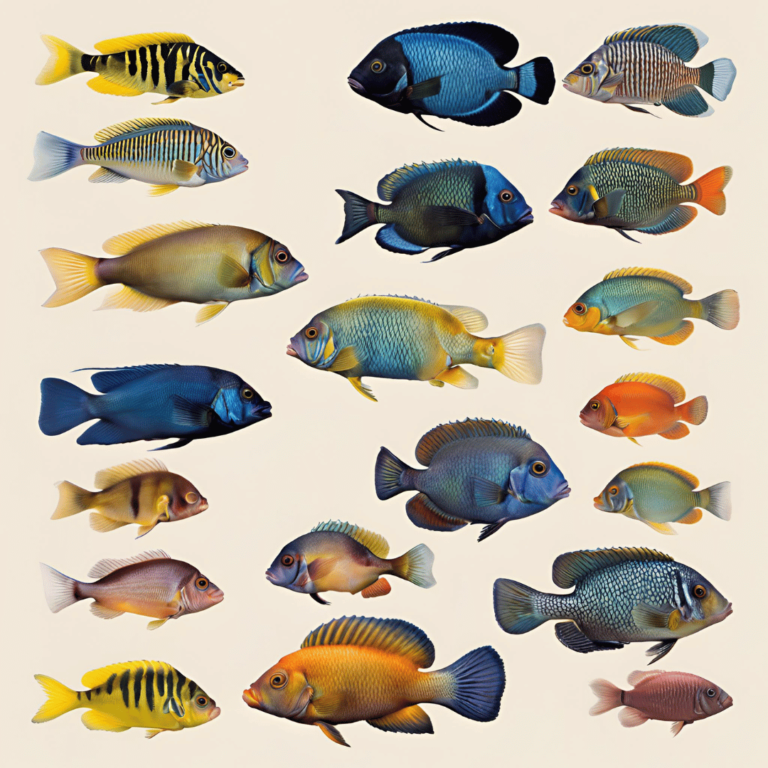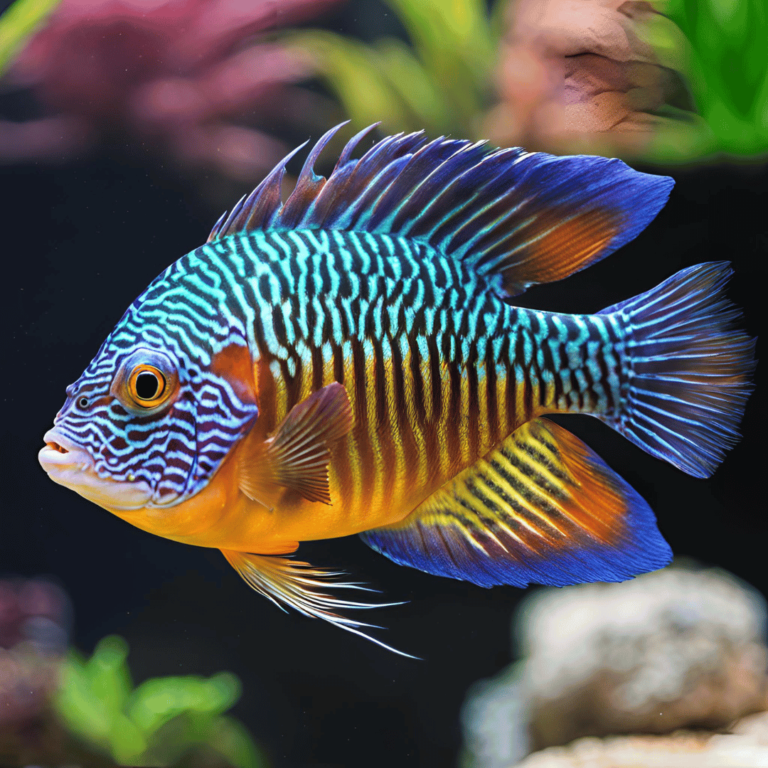Your trusted guide to cichlid care, tank setups, and quality products.

Top 7 Common Peacock Cichlid Diseases and Prevention Tips
Stay ahead of common peacock cichlid diseases with our comprehensive guide! Learn to recognize early warning signs, prevent infections, and effectively treat common ailments. Ensure the health and well-being of your beloved fish.
Image credit Canva
Peacock cichlids are prized for their vibrant colors and engaging personalities, making them a popular choice among aquarists. However, like all fish, Peacock Cichlid Diseases can pose a significant threat to their health and well-being. Understanding how to prevent and treat Peacock Cichlid Diseases is essential to keeping your fish healthy and thriving. In this comprehensive guide, we’ll explore the top seven most common Peacock Cichlid Diseases, symptoms to watch out for, and effective treatments.
At PeacockCichlid.com, we believe in transparency and honesty with our readers. Some of the links in this article are affiliate links, which means we may earn a small commission if you make a purchase through them—at no additional cost to you. These commissions help support our site, allowing us to continue providing expert advice, in-depth guides, and valuable content for Peacock Cichlid enthusiasts like you.
We only recommend products that we trust and believe will be beneficial for your aquarium. Thank you for your support!
Common Peacock Cichlid Diseases and How to Prevent Them
Proper care is the best defense against common Peacock Cichlid Diseases. Many diseases stem from poor water quality, stress, or an improper diet. Let’s dive into the seven most common Peacock Cichlid Diseases, their symptoms, treatments, and prevention methods.
1. Ich (White Spot Disease) – A Common Peacock Cichlid Disease
Ich is one of the most common Peacock Cichlid Diseases. It’s a parasitic disease that manifests as small white spots on the body, fins, and gills of your fish. This disease is highly contagious and often triggered by stress or poor water conditions, making it a common problem in aquariums.
Symptoms:
- White spots on the body and fins, resembling grains of salt.
- Scratching or rubbing against objects in the tank as the fish tries to relieve irritation.
- Labored breathing, especially if the gills are affected by the parasite.
Treatment:
- Gradually raise the water temperature to 86°F over 24-48 hours to accelerate the parasite’s life cycle.
- Use a commercial ich treatment containing malachite green or formalin, following the manufacturer’s instructions.
- Quarantine infected fish to prevent the spread of Peacock Cichlid Diseases to healthy tankmates.
Prevention:
- Maintain stable water conditions by regularly monitoring and adjusting pH, temperature, and ammonia levels.
- Quarantine new fish for at least two weeks before introducing them to your main tank to avoid introducing Peacock Cichlid Diseases like ich.
- Avoid overcrowding, as stress from limited space can make fish more susceptible to ich and other Peacock Cichlid Diseases.
2. Malawi Bloat – A Severe Peacock Cichlid Disease
Malawi Bloat is another severe Peacock Cichlid Disease that affects cichlids. It is usually caused by overfeeding, a high-protein diet, or poor water quality, all of which can disrupt the fish’s digestive system.
Symptoms:
- A visibly swollen abdomen that may appear bloated or distended.
- Loss of appetite, where the fish refuses to eat despite normal feeding times.
- Rapid or heavy breathing, often accompanied by lethargy and unusual swimming patterns.
Treatment:
- Immediately quarantine affected fish in a hospital tank to prevent the condition from spreading.
- Administer medications specifically designed for Malawi Bloat, such as those containing metronidazole.
- Add Epsom salts (magnesium sulfate) to the water to help reduce swelling and improve the fish’s overall condition.
Prevention:
- Feed your fish a varied and balanced diet, incorporating high-quality pellets, vegetable-based foods, and occasional live or frozen treats to avoid Peacock Cichlid Diseases like Malawi Bloat.
- Avoid overfeeding by providing only the amount of food your fish can consume in a few minutes.
- Perform regular water changes and clean the substrate to remove uneaten food and waste, which can contribute to poor water quality and lead to Peacock Cichlid Diseases.
3. Fin Rot – A Treatable Peacock Cichlid Disease
Fin Rot is a bacterial infection that attacks the fins, causing them to appear ragged or discolored. It is another common Peacock Cichlid Disease often resulting from poor water conditions, injuries, or stress.
Symptoms:
- Torn, ragged, or frayed fins that may appear translucent or discolored.
- Red or inflamed edges on the fins, indicating the presence of infection.
Treatment:
- Treat the tank with antibacterial medications specifically designed for fin rot.
- Improve tank conditions by performing frequent water changes and removing debris or uneaten food to prevent Peacock Cichlid Diseases like fin rot.
Prevention:
- Avoid overcrowding your tank, as aggressive interactions can lead to fin injuries and subsequent Peacock Cichlid Diseases.
- Maintain pristine water quality by regularly testing and adjusting water parameters.
- Introduce hiding spots and decorations to reduce stress and minimize aggressive behavior among fish.
4. Hole-in-the-Head Disease (Hexamita) – A Notable Peacock Cichlid Disease
Hole-in-the-Head Disease is a parasitic condition and a notable Peacock Cichlid Disease that causes small pits or holes to form on the head and body of peacock cichlids. This disease is often linked to poor water quality, nutritional deficiencies, or prolonged stress.
Symptoms:
- Small, round pits or holes on the head and along the lateral line of the fish.
- Weight loss and reduced appetite, despite normal feeding practices.
- Lethargy and dull coloration, indicating a decline in overall health.
Treatment:
- Use medications containing metronidazole or similar antiparasitic agents to treat the infection.
- Enhance the fish’s diet by adding high-quality, nutrient-rich foods and vitamin supplements.
Prevention:
- Provide a balanced diet that includes a variety of proteins, vegetables, and fortified foods to prevent nutritional deficiencies and Peacock Cichlid Diseases.
- Maintain a clean and stress-free tank environment with proper filtration and regular water changes.
5. Fungal Infections – Common Peacock Cichlid Diseases
Fungal infections are common Peacock Cichlid Diseases, especially when the fish have sustained injuries or are exposed to poor water conditions. These infections appear as white, cotton-like growths on the fish’s body or fins.
Symptoms:
- White, fluffy growths on the skin, fins, or gills, resembling cotton wool.
- Lethargy and loss of appetite, often accompanied by secondary infections.
Treatment:
- Administer antifungal medications specifically designed for aquarium fish.
- Provide salt baths to affected fish to reduce fungal growth and improve healing.
Prevention:
- Keep water conditions pristine by performing regular water changes and maintaining proper filtration.
- Remove sharp or abrasive objects from the tank to prevent injuries that could lead to Peacock Cichlid Diseases.
6. Swim Bladder Disease – A Common Peacock Cichlid Ailment
Swim bladder disease is a disorder that affects a fish’s ability to control buoyancy. It’s often caused by overfeeding, bacterial infections, or genetic issues.
Symptoms:
- Difficulty swimming or maintaining balance in the water column.
- Floating to the surface or sinking to the bottom of the tank.
- Curved body posture due to internal pressure.
Treatment:
- Feed the fish boiled, shelled peas to alleviate constipation-related swim bladder issues.
- Use antibacterial medications if the condition is caused by infection.
- Isolate the affected fish and provide a stress-free environment for recovery.
Prevention:
- Avoid overfeeding and provide a varied diet that includes fiber-rich foods.
- Maintain clean water conditions to reduce the risk of bacterial infections.
7. Velvet Disease – A Lesser-Known Peacock Cichlid Disease
Velvet disease, caused by a parasitic dinoflagellate, is a Peacock Cichlid Disease that results in a fine gold or rust-colored coating on the fish’s skin.
Symptoms:
- Gold or rusty spots on the body, giving the fish a velvety appearance.
- Rapid gill movements and lethargy.
- Loss of appetite and clamped fins.
Treatment:
- Use copper-based medications to eliminate the parasite effectively.
- Dim the aquarium lights, as the parasite relies on light for survival.
- Quarantine infected fish to prevent the spread of the disease.
Prevention:
- Maintain good water quality and avoid sudden changes in tank conditions.
- Quarantine new fish to ensure they are not carrying Velvet Disease.
Preventing Peacock Cichlid Diseases
Preventing Peacock Cichlid Diseases requires diligence and proper tank maintenance. Here are some general prevention tips:
- Maintain Water Quality: Regularly monitor and adjust water parameters such as pH, ammonia, and temperature.
- Balanced Diet: Provide varied, high-quality food to meet nutritional needs.
- Quarantine New Fish: Always quarantine new additions to avoid introducing Peacock Cichlid Diseases.
- Regular Observation: Watch for behavioral changes that may indicate early signs of illness.
Conclusion
Understanding Peacock Cichlid Diseases and their prevention is vital for maintaining a thriving aquarium. By staying vigilant about water quality, diet, and regular monitoring, you can minimize the risk of Peacock Cichlid Diseases and enjoy the beauty and charm of these vibrant fish for years to come. Proper care, combined with prompt action when signs of illness appear, will ensure that your peacock cichlids lead healthy, happy lives in their aquatic environment.
Enhance your peacock cichlid journey by exploring our other expert guides available on peacochcichlid.com. If you’re looking to keep your aquarium in top shape, be sure to check out Peacock Cichlid Tank Maintenance: 14 Proven Tips for Success and discover practical advice in 7 Expert Tips to Maintain Water Quality for Peacock Cichlids. For insights on stress prevention, our article 10 Signs of Peacock Cichlid Stress and How to Prevent It offers invaluable tips, while Peacock Cichlid Care: 7 Powerful Tips for Beginners is perfect for those just starting out.
Each of these resources is designed to complement the disease prevention strategies discussed here, ensuring you have a well-rounded approach to maintaining a healthy and vibrant tank. We invite you to visit us again at peacochcichlid.com for more tips, updates, and expert advice, and don’t forget to follow us on social media to stay connected with our latest news and insights!
FAQ’s
What are the most common Peacock Cichlid Diseases?
The most common diseases include ich, Malawi bloat, fin rot, hole-in-the-head disease, fungal infections, swim bladder disease, and velvet disease.
How can I prevent Peacock Cichlid Diseases?
Maintain water quality, provide a balanced diet, and quarantine new fish before adding them to your tank.
What should I do if my peacock cichlid has white spots?
White spots often indicate ich. Treat the tank with a commercial ich medication and raise the water temperature gradually.
Can stress lead to Peacock Cichlid Diseases?
Yes, stress weakens the immune system and makes fish more susceptible to diseases like ich and fin rot.
Is hole-in-the-head disease contagious?
Hole-in-the-head disease is not highly contagious but requires prompt treatment to prevent complications.
What causes Malawi bloat in peacock cichlids?
Malawi bloat is caused by overfeeding, a high-protein diet, and poor water conditions.
How do I treat fungal infections in peacock cichlids?
Use antifungal medications and salt baths to treat fungal infections effectively.
Why are my peacock cichlid’s fins frayed?
Frayed fins are a symptom of fin rot, often caused by poor water quality or injuries.
Do peacock cichlids need special food to avoid diseases?
Yes, providing a varied diet with high-quality pellets, vegetables, and occasional treats helps prevent diseases.
How often should I clean my aquarium to prevent Peacock Cichlid Diseases?
Perform weekly water changes and regularly clean the substrate and filters to maintain a healthy environment.



